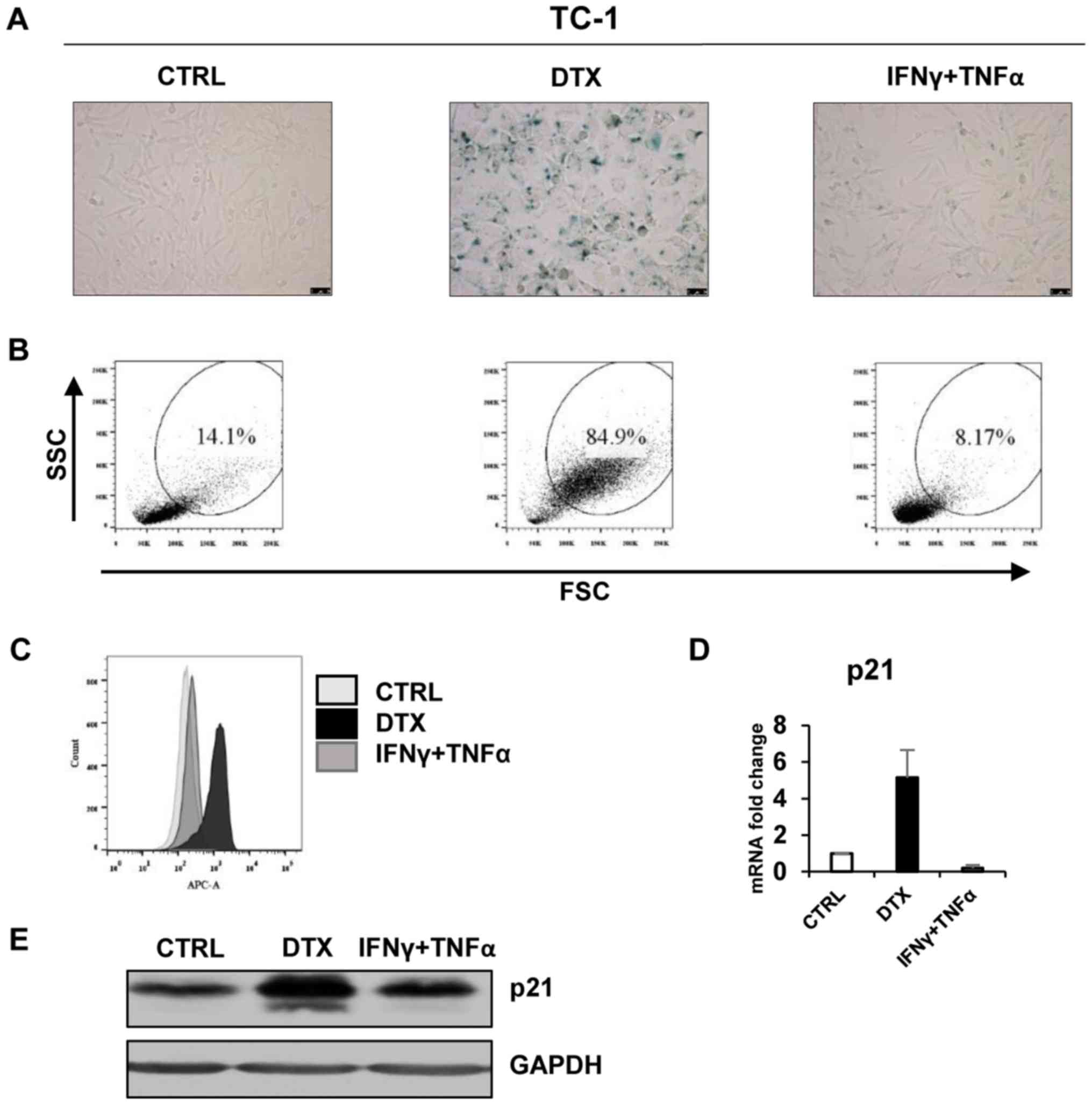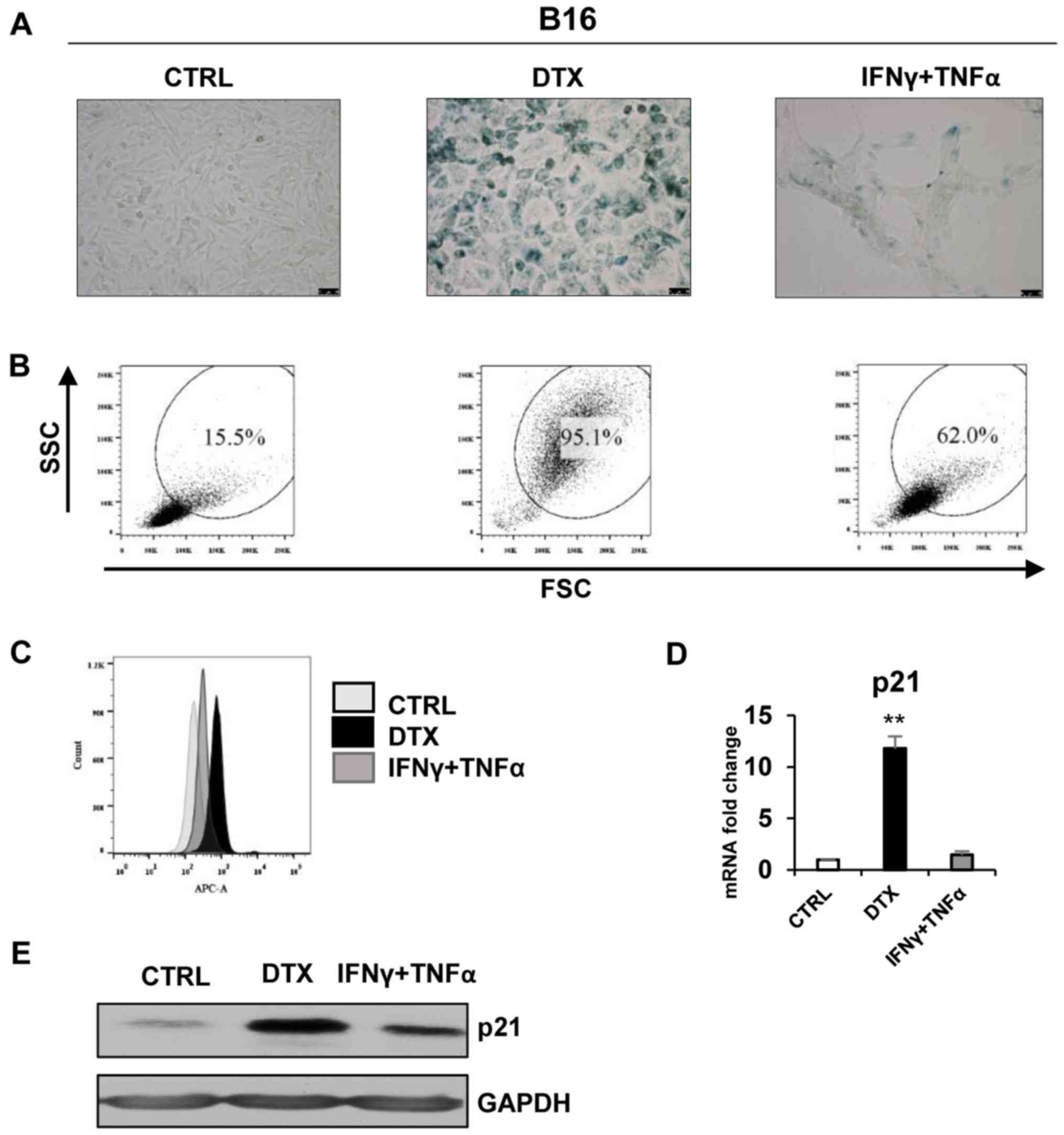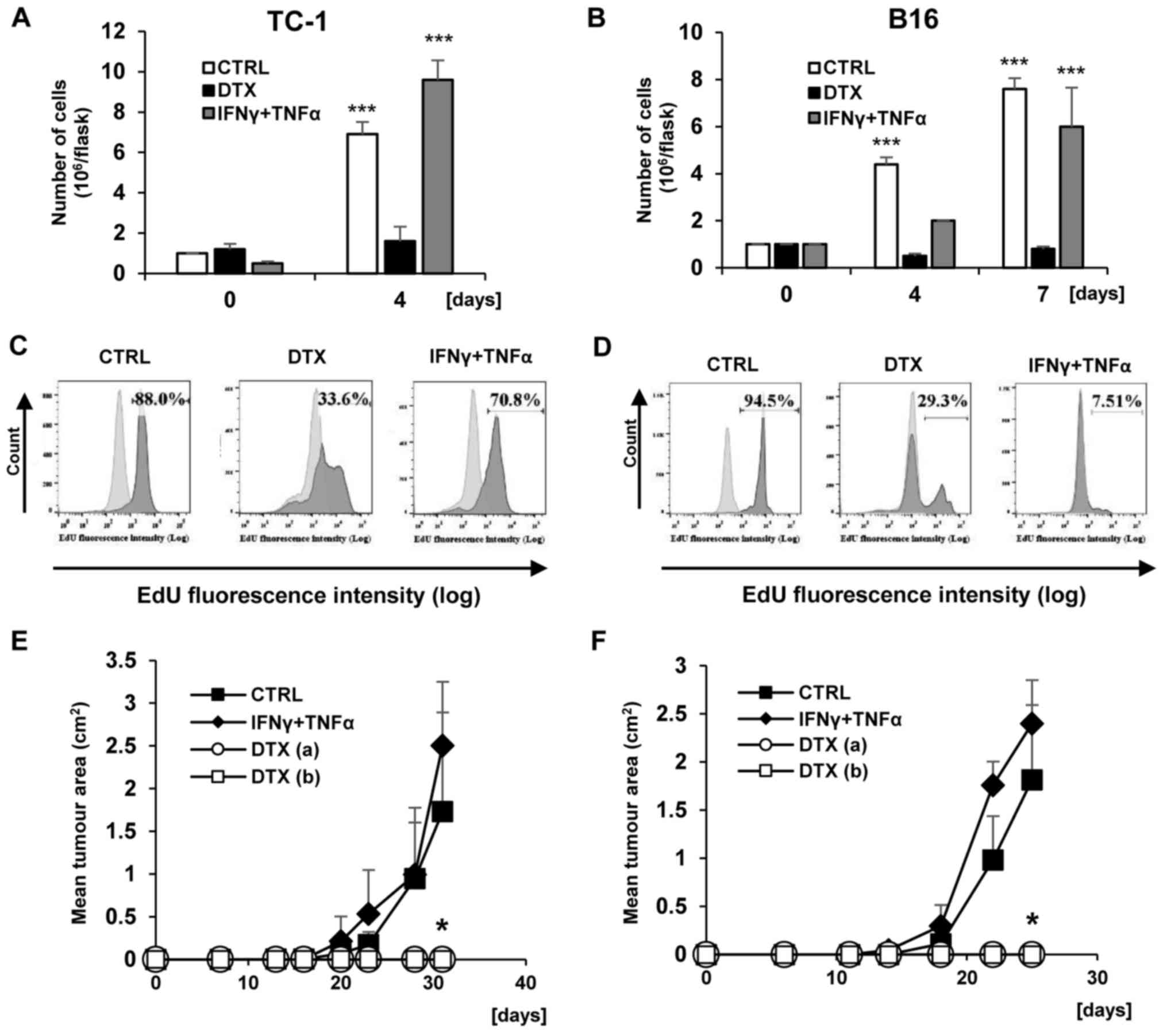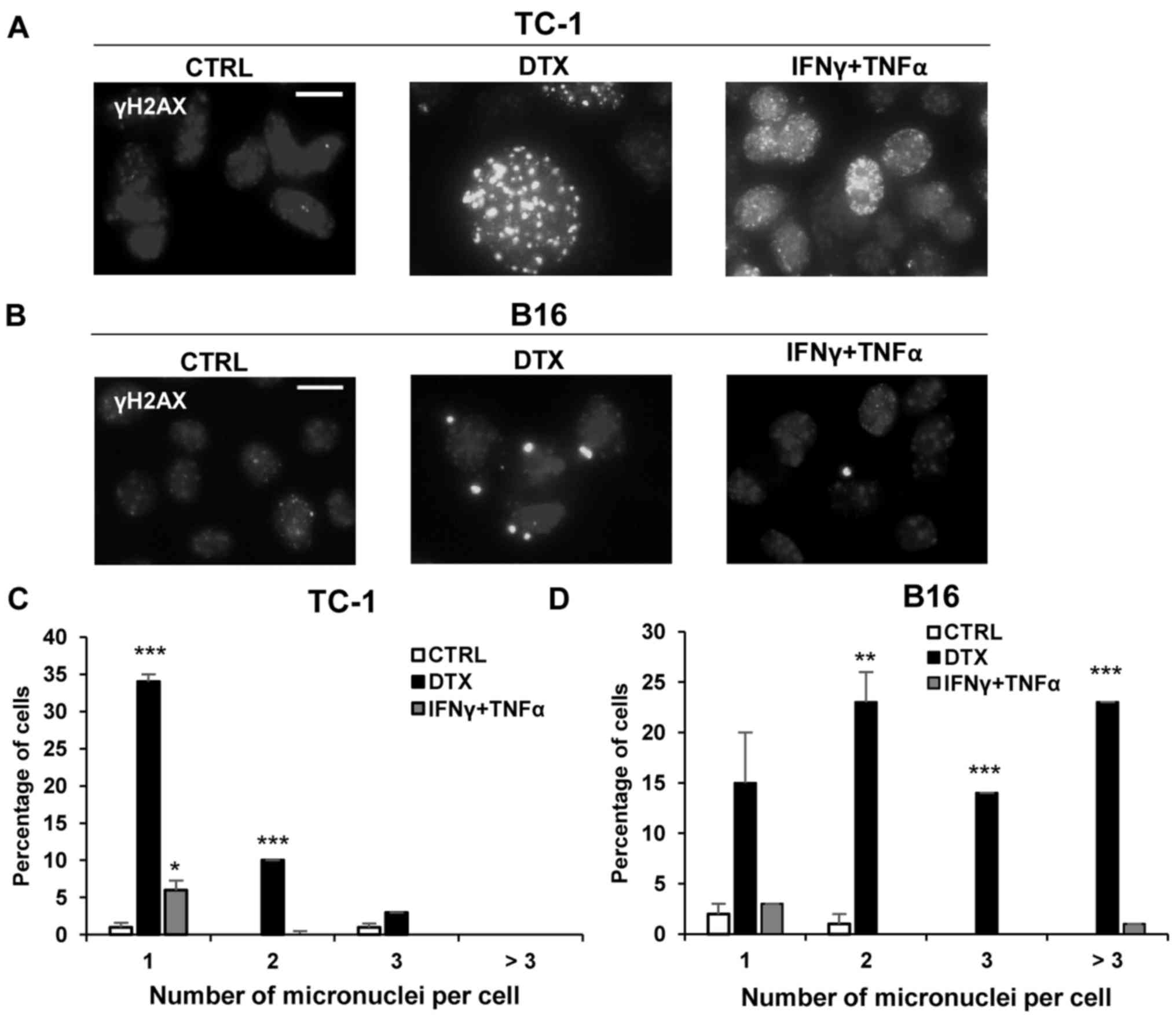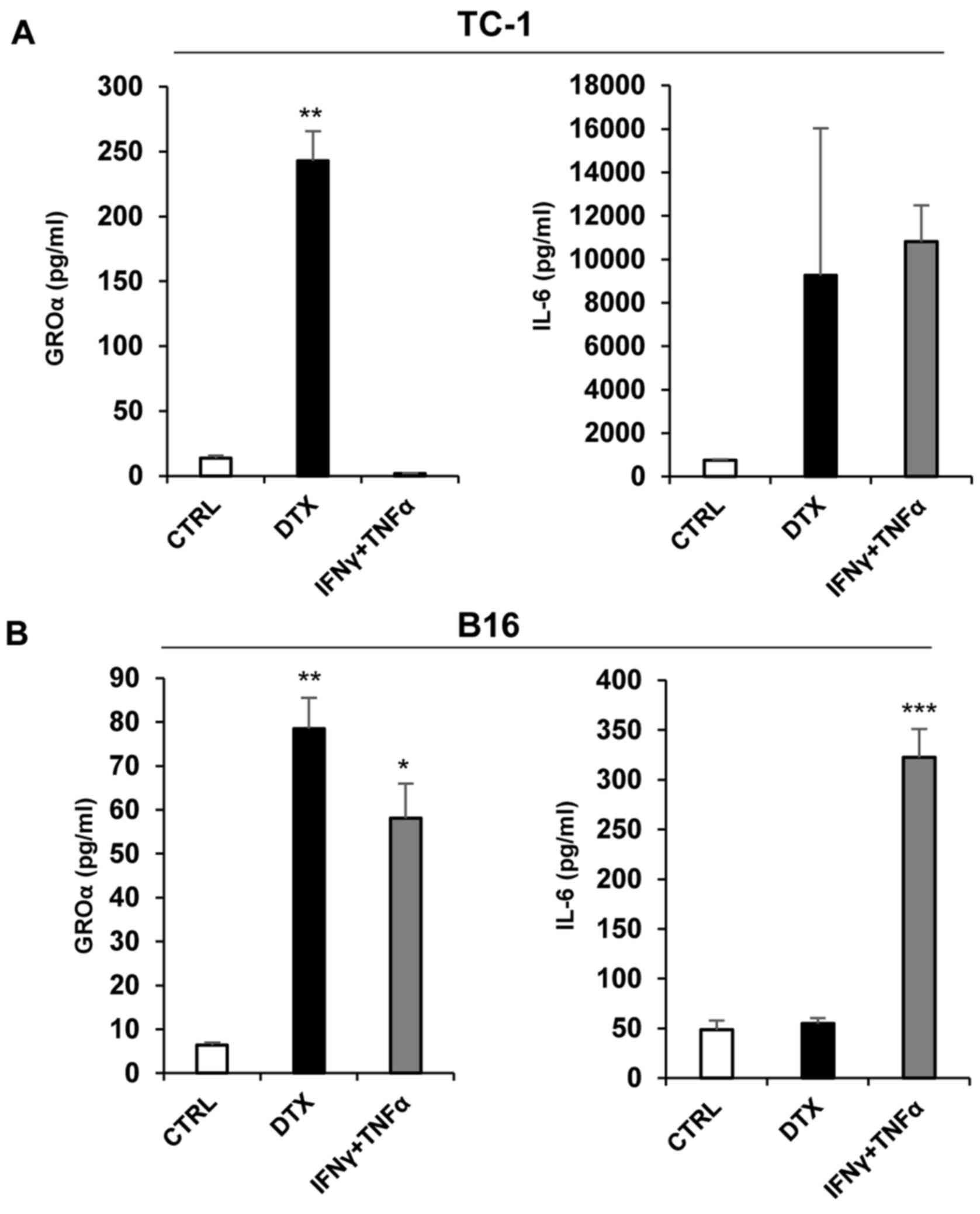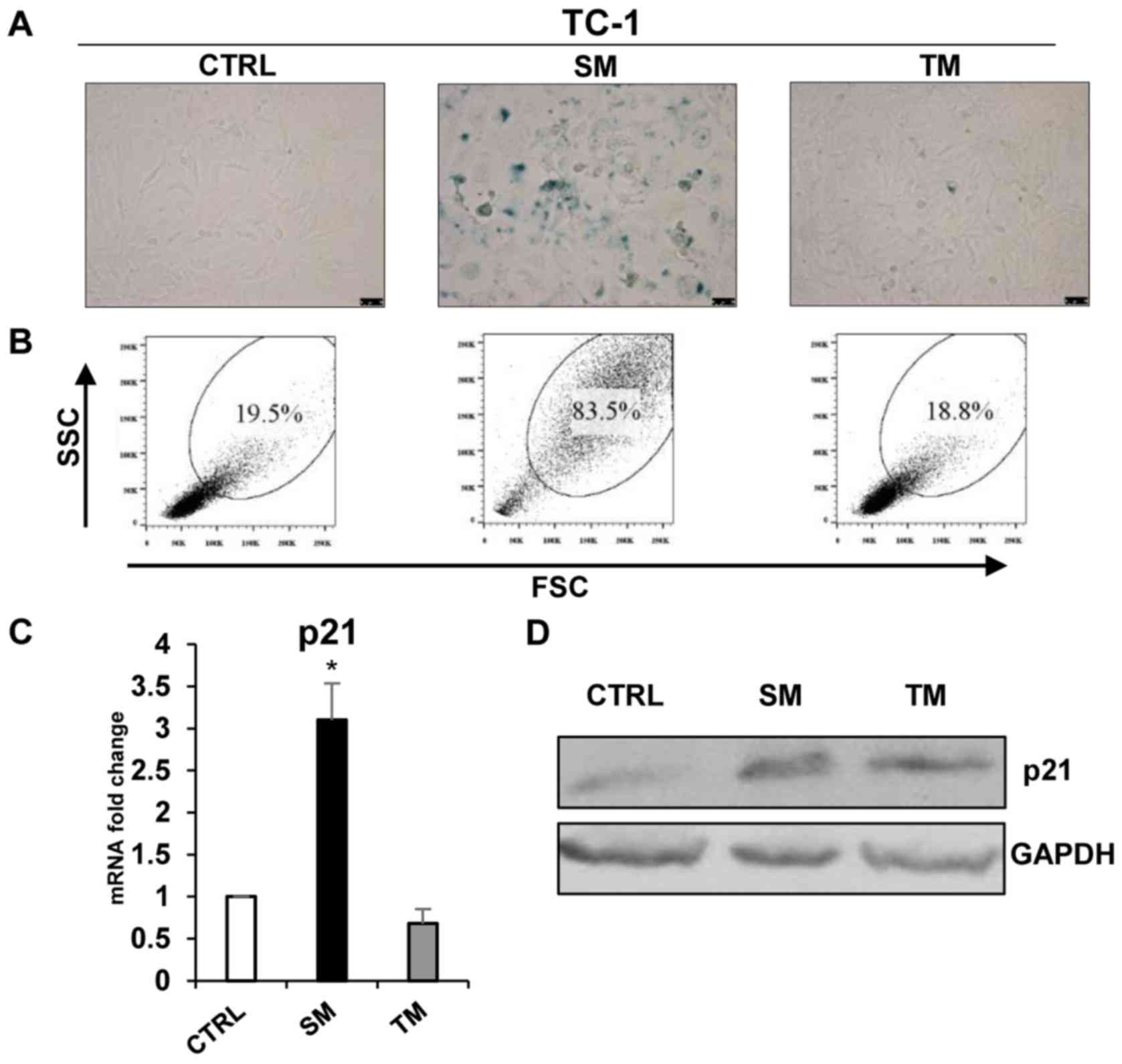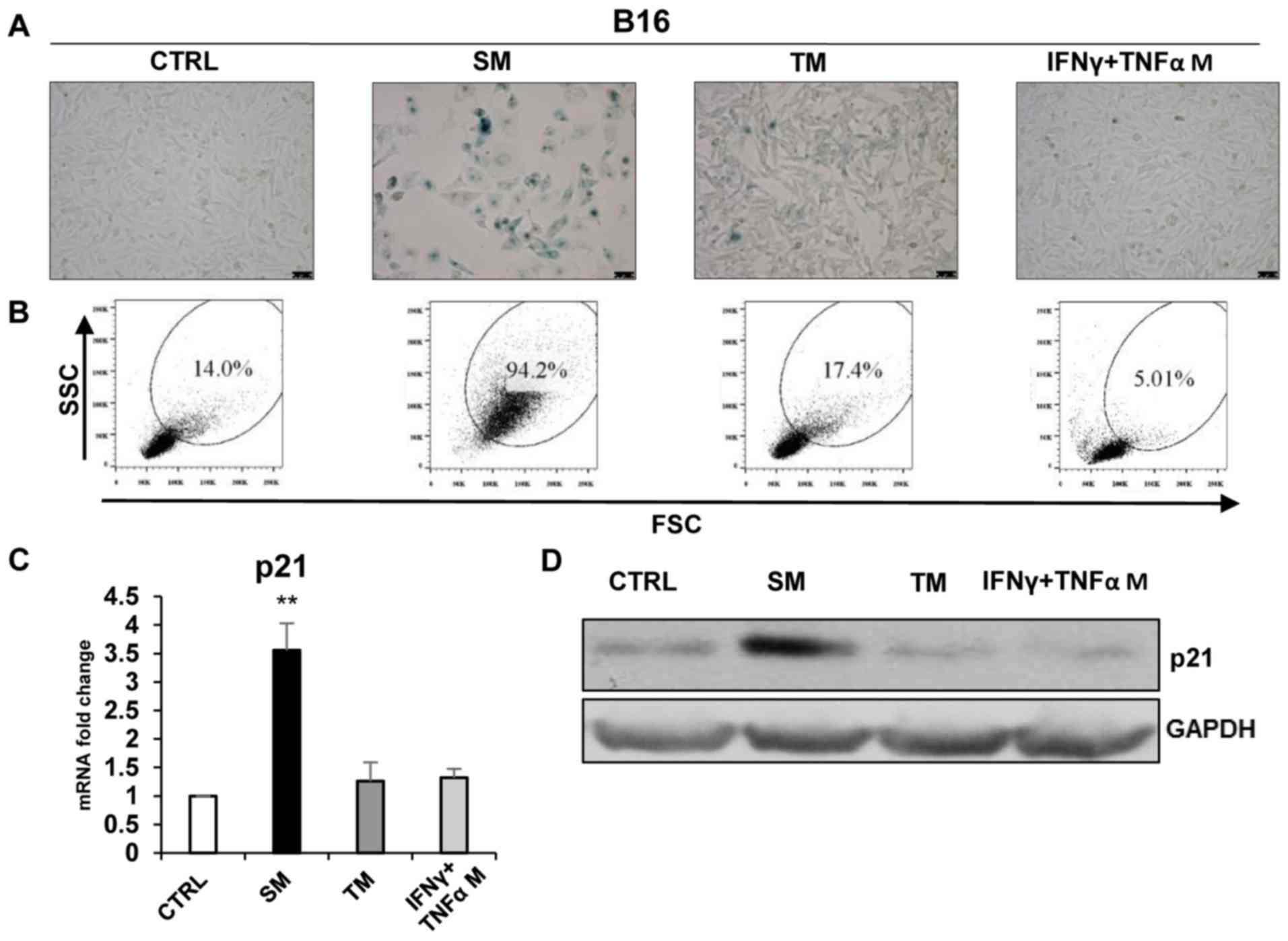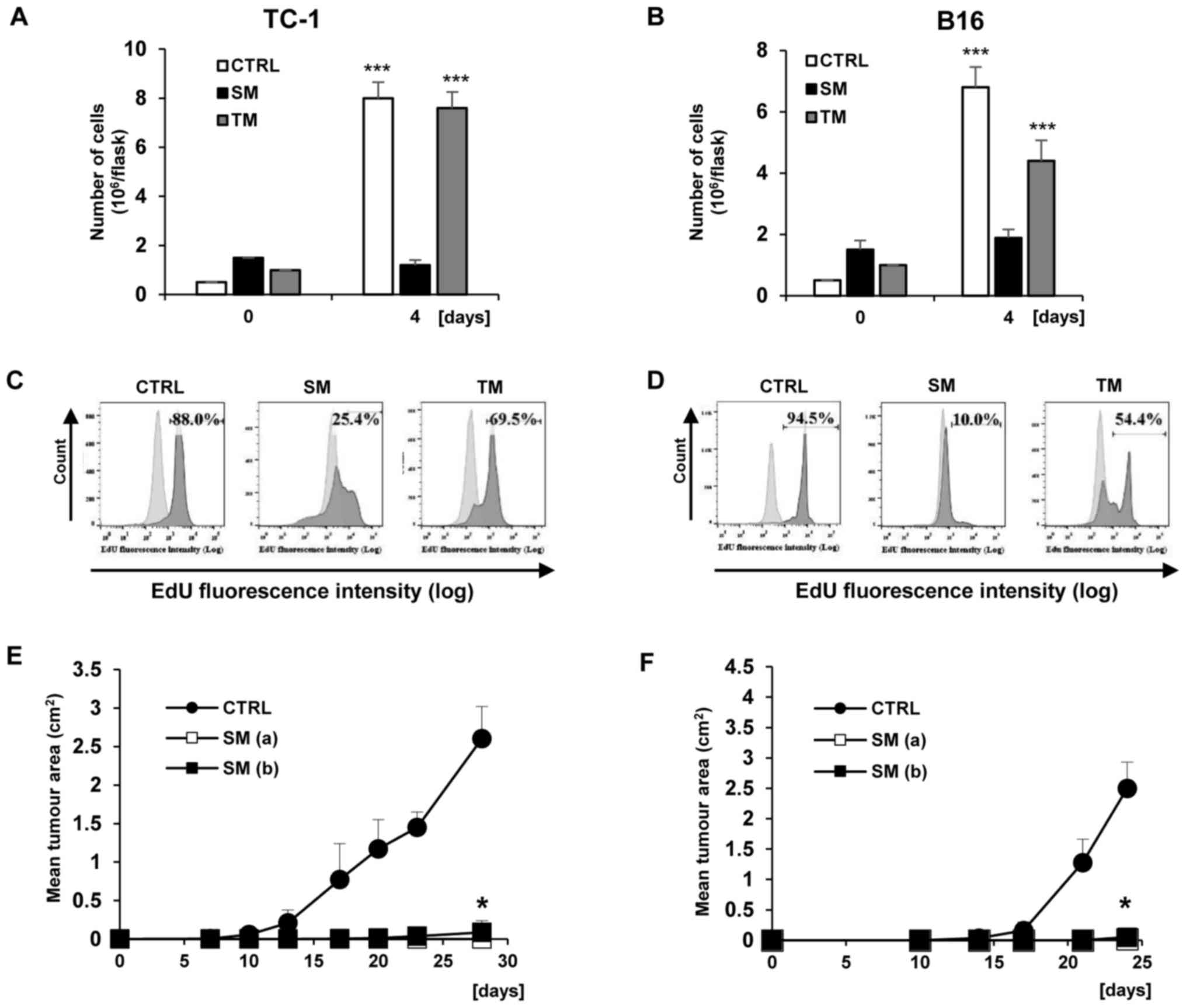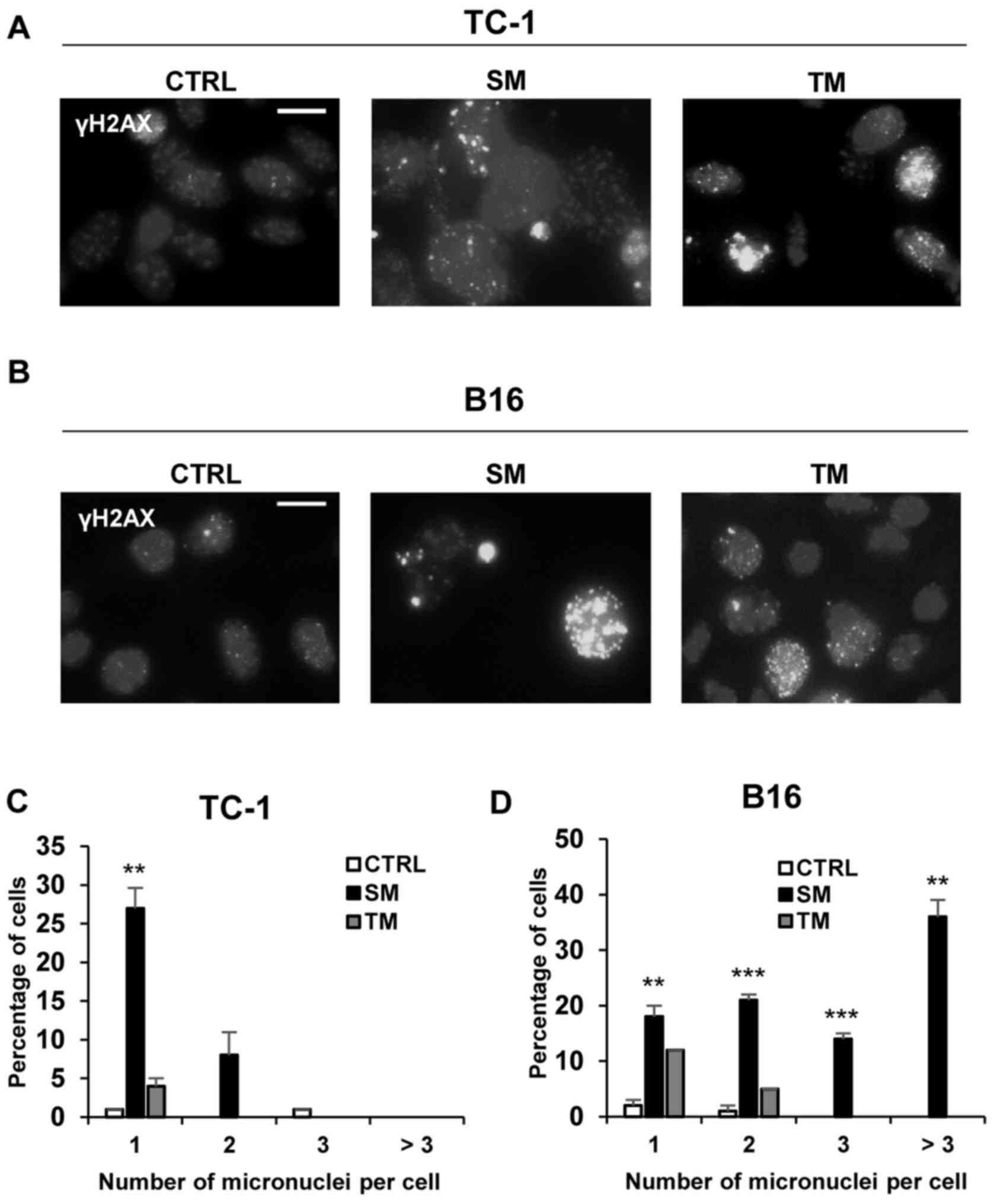|
1
|
Coppé JP, Desprez PY, Krtolica A and
Campisi J: The senescence-associated secretory phenotype: The dark
side of tumor suppression. Annu Rev Pathol. 5:99–118. 2010.
View Article : Google Scholar : PubMed/NCBI
|
|
2
|
Coppé JP, Patil CK, Rodier F, Sun Y, Muñoz
DP, Goldstein J, Nelson PS, Desprez PY and Campisi J:
Senescence-asso ciated secretory phenotypes reveal
cell-nonautonomous functions of oncogenic RAS and the p53 tumor
suppressor. PLoS Biol. 6:2853–2868. 2008. View Article : Google Scholar
|
|
3
|
Benvenuti S, Cramer R, Bruce J, Waterfield
MD and Jat PS: Identification of novel candidates for replicative
senescence by functional proteomics. Oncogene. 21:4403–4413. 2002.
View Article : Google Scholar : PubMed/NCBI
|
|
4
|
Bringold F and Serrano M: Tumor
suppressors and oncogenes in cellular senescence. Exp Gerontol.
35:317–329. 2000. View Article : Google Scholar : PubMed/NCBI
|
|
5
|
Cristofalo VJ, Lorenzini A, Allen RG,
Torres C and Tresini M: Replicative senescence: A critical review.
Mech Ageing Dev. 125:827–848. 2004. View Article : Google Scholar : PubMed/NCBI
|
|
6
|
Salama R, Sadaie M, Hoare M and Narita M:
Cellular senescence and its effector programs. Genes Dev.
28:99–114. 2014. View Article : Google Scholar : PubMed/NCBI
|
|
7
|
Pluquet O, Pourtier A and Abbadie C: The
unfolded protein response and cellular senescence. A review in the
theme: Cellular mechanisms of endoplasmic reticulum stress
signaling in health and disease. Am J Physiol Cell Physiol.
308:C415–C425. 2015. View Article : Google Scholar
|
|
8
|
Kojima H, Inoue T, Kunimoto H and Nakajima
K: IL-6STAT3signaling and premature senescence. JAK-STAT.
2:e257632013. View Article : Google Scholar
|
|
9
|
Hayflick L and Moorhead PS: The serial
cultivation of human diploid cell strains. Exp Cell Res.
25:585–621. 1961. View Article : Google Scholar : PubMed/NCBI
|
|
10
|
d’Adda di Fagagna F, Reaper PM,
Clay-Farrace L, Fiegler H, Carr P, Von Zglinicki T, Saretzki G,
Carter NP and Jackson SP: A DNA damage checkpoint response in
telomere-initiated senescence. Nature. 426:194–198. 2003.
View Article : Google Scholar
|
|
11
|
Harley CB, Futcher AB and Greider CW:
Telomeres shorten during ageing of human fibroblasts. Nature.
345:458–460. 1990. View
Article : Google Scholar : PubMed/NCBI
|
|
12
|
Blazkova H, Krejcikova K, Moudry P, Frisan
T, Hodny Z and Bartek J: Bacterial intoxication evokes cellular
senescence with persistent DNA damage and cytokine signalling. J
Cell Mol Med. 14:357–367. 2010. View Article : Google Scholar
|
|
13
|
Cairney CJ, Bilsland AE, Evans TR, Roffey
J, Bennett DC, Narita M, Torrance CJ and Keith WN: Cancer cell
senescence: A new frontier in drug development. Drug Discov Today.
17:269–276. 2012. View Article : Google Scholar : PubMed/NCBI
|
|
14
|
Kuilman T, Michaloglou C, Mooi WJ and
Peeper DS: The essence of senescence. Genes Dev. 24:2463–2479.
2010. View Article : Google Scholar : PubMed/NCBI
|
|
15
|
Pascal T, Debacq-Chainiaux F, Chrétien A,
Bastin C, Dabée AF, Bertholet V, Remacle J and Toussaint O:
Comparison of replicative senescence and stress-induced premature
senescence combining differential display and low-density DNA
arrays. FEBS Lett. 579:3651–3659. 2005. View Article : Google Scholar : PubMed/NCBI
|
|
16
|
Davalos AR, Coppe JP, Campisi J and
Desprez PY: Senescent cells as a source of inflammatory factors for
tumor progression. Cancer Metastasis Rev. 29:273–283. 2010.
View Article : Google Scholar : PubMed/NCBI
|
|
17
|
Hubackova S, Krejcikova K, Bartek J and
Hodny Z: IL1- and TGFβ-Nox4 signaling, oxidative stress and DNA
damage response are shared features of replicative,
oncogene-induced, and drug-induced paracrine ‘bystander
senescence’. Aging (Albany NY). 4:932–951. 2012. View Article : Google Scholar
|
|
18
|
Calcinotto A and Alimonti A: Aging tumour
cells to cure cancer: ‘pro-senescence’ therapy for cancer. Swiss
Med Wkly. 147:w143672017.
|
|
19
|
Ortiz-Montero P, Londoño-Vallejo A and
Vernot JP: Senescence- associated IL-6 and IL-8 cytokines induce a
self- and cross-reinforced senescence/inflammatory milieu
strengthening tumorigenic capabilities in the MCF-7 breast cancer
cell line. Cell Commun Signal. 15:172017. View Article : Google Scholar
|
|
20
|
Rodier F and Campisi J: Four faces of
cellular senescence. J Cell Biol. 192:547–556. 2011. View Article : Google Scholar : PubMed/NCBI
|
|
21
|
Nelson G, Wordsworth J, Wang C, Jurk D,
Lawless C, Martin- Ruiz C and von Zglinicki T: A senescent cell
bystander effect: Senescence-induced senescence. Aging Cell.
11:345–349. 2012. View Article : Google Scholar : PubMed/NCBI
|
|
22
|
Hodny Z, Hubackova S and Bartek J:
Cytokines shape chemotherapy-induced and ‘bystander’ senescence.
Aging (Albany NY). 2:375–376. 2010. View Article : Google Scholar
|
|
23
|
Kuilman T, Michaloglou C, Vredeveld LC,
Douma S, van Doorn R, Desmet CJ, Aarden LA, Mooi WJ and Peeper DS:
Oncogene-induced senescence relayed by an interleukin-dependent
inflammatory network. Cell. 133:1019–1031. 2008. View Article : Google Scholar : PubMed/NCBI
|
|
24
|
Ozturk M, Arslan-Ergul A, Bagislar S,
Senturk S and Yuzugullu H: Senescence and immortality in
hepatocellular carcinoma. Cancer Lett. 286:103–113. 2009.
View Article : Google Scholar
|
|
25
|
Koturbash I, Rugo RE, Hendricks CA, Loree
J, Thibault B, Kutanzi K, Pogribny I, Yanch JC, Engelward BP and
Kovalchuk O: Irradiation induces DNA damage and modulates
epigenetic effectors in distant bystander tissue in vivo. Oncogene.
25:4267–4275. 2006. View Article : Google Scholar : PubMed/NCBI
|
|
26
|
Zhou H, Randers-Pehrson G, Waldren CA,
Vannais D, Hall EJ and Hei TK: Induction of a bystander mutagenic
effect of alpha particles in mammalian cells. Proc Natl Acad Sci
USA. 97:2099–2104. 2000. View Article : Google Scholar : PubMed/NCBI
|
|
27
|
Braumüller H, Wieder T, Brenner E, Aßmann
S, Hahn M, Alkhaled M, Schilbach K, Essmann F, Kneilling M,
Griessinger C, et al: T-helper-1-cell cytokines drive cancer into
senescence. Nature. 494:361–365. 2013. View Article : Google Scholar : PubMed/NCBI
|
|
28
|
Simova J, Sapega O, Imrichova T, Stepanek
I, Kyjacova L, Mikyskova R, Indrova M, Bieblova J, Bubenik J,
Bartek J, et al: Tumor growth accelerated by chemotherapy-induced
senescent cells is suppressed by treatment with IL-12 producing
cellular vaccines. Oncotarget. 7:54952–54964. 2016. View Article : Google Scholar : PubMed/NCBI
|
|
29
|
Lin KY, Guarnieri FG, Staveley-O’Carroll
KF, Levitsky HI, August JT, Pardoll DM and Wu TC: Treatment of
established tumors with a novel vaccine that enhances major
histocompatibility class II presentation of tumor antigen. Cancer
Res. 56:21–26. 1996.PubMed/NCBI
|
|
30
|
Overwijk WW and Restifo NP: B16 as a mouse
model for human melanoma. Curr Protoc Immunol Chapter: 20 Unit.
20:12001.
|
|
31
|
Livak KJ and Schmittgen TD: Analysis of
relative gene expression data using real-time quantitative PCR and
the 2(-Delta Delta C(T)) method. Methods. 25:402–408. 2001.
View Article : Google Scholar
|
|
32
|
Ramirez JM, Bai Q, Péquignot M, Becker F,
Kassambara A, Bouin A, Kalatzis V, Dijon-Grinand M and De Vos J:
Side scatter intensity is highly heterogeneous in undifferentiated
pluripotent stem cells and predicts clonogenic self-renewal. Stem
Cells Dev. 22:1851–1860. 2013. View Article : Google Scholar : PubMed/NCBI
|
|
33
|
Zhang YH, Lin JX and Vilcek J:
Interleukin-6 induction by tumor necrosis factor and interleukin-1
in human fibroblasts involves activation of a nuclear factor
binding to a kappa B-like sequence. Mol Cell Biol. 10:3818–3823.
1990. View Article : Google Scholar : PubMed/NCBI
|
|
34
|
Hubackova S, Kucerova A, Michlits G,
Kyjacova L, Reinis M, Korolov O, Bartek J and Hodny Z: IFNγ induces
oxidative stress, DNA damage and tumor cell senescence via
TGFβ/SMAD signaling-dependent induction of Nox4 and suppression of
ANT2. Oncogene. 35:1236–1249. 2016. View Article : Google Scholar
|
|
35
|
Mukherjee S, Debata PR, Hussaini R,
Chatterjee K, Baidoo JN, Sampat S, Szerszen A, Navarra JP, Fata J,
Severinova E, et al: Unique synergistic formulation of curcumin,
epicatechin gallate and resveratrol, tricurin, suppresses HPV E6,
eliminates HPV+ cancer cells, and inhibits tumor
progression. Oncotarget. 8:60904–60916. 2017.PubMed/NCBI
|
|
36
|
Novakova Z, Hubackova S, Kosar M,
Janderova-Rossmeislova L, Dobrovolna J, Vasicova P, Vancurova M,
Horejsi Z, Hozak P, Bartek J, et al: Cytokine expression and
signaling in drug- induced cellular senescence. Oncogene.
29:273–284. 2010. View Article : Google Scholar
|
|
37
|
Ringel I and Horwitz SB: Studies with RP
56976 (taxotere): A semisynthetic analogue of taxol. J Natl Cancer
Inst. 83:288–291. 1991. View Article : Google Scholar : PubMed/NCBI
|
|
38
|
Schwarze SR, Fu VX, Desotelle JA, Kenowski
ML and Jarrard DF: The identification of senescence-specific genes
during the induction of senescence in prostate cancer cells.
Neoplasia. 7:816–823. 2005. View Article : Google Scholar : PubMed/NCBI
|
|
39
|
Di Mitri D, Toso A, Chen JJ, Sarti M,
Pinton S, Jost TR, D’Antuono R, Montani E, Garcia-Escudero R,
Guccini I, et al: Tumour-infiltrating Gr-1+ myeloid cells
antagonize senescence in cancer. Nature. 515:134–137. 2014.
View Article : Google Scholar : PubMed/NCBI
|
|
40
|
Hernández-Vargas H, Palacios J and
Moreno-Bueno G: Molecular profiling of docetaxel cytotoxicity in
breast cancer cells: Uncoupling of aberrant mitosis and apoptosis.
Oncogene. 26:2902–2913. 2007. View Article : Google Scholar
|
|
41
|
Hernández-Vargas H, Palacios J and
Moreno-Bueno G: Telling cells how to die: Docetaxel therapy in
cancer cell lines. Cell Cycle. 6:780–783. 2007. View Article : Google Scholar : PubMed/NCBI
|
|
42
|
Mikyšková R, Štěpánek I, Indrová M,
Bieblová J, Šímová J, Truxová I, Moserová I, Fučíková J, Bartůňková
J, Špíšek R, et al: Dendritic cells pulsed with tumor cells killed
by high hydrostatic pressure induce strong immune responses and
display therapeutic effects both in murine TC-1 and TRAMP-C2 tumors
when combined with docetaxel chemotherapy. Int J Oncol. 48:953–964.
2016. View Article : Google Scholar
|
|
43
|
Kakimi K, Matsushita H, Hosoi A, Miyai M
and Ohara O: CTLs regulate tumor growth via cytostatic effects
rather than cytotoxicity: A few T cells can influence the growth of
many times more tumor cells. OncoImmunology. 4:e9704642014.
View Article : Google Scholar
|
|
44
|
Bartek J, Hodny Z and Lukas J: Cytokine
loops driving senescence. Nat Cell Biol. 10:887–889. 2008.
View Article : Google Scholar : PubMed/NCBI
|



